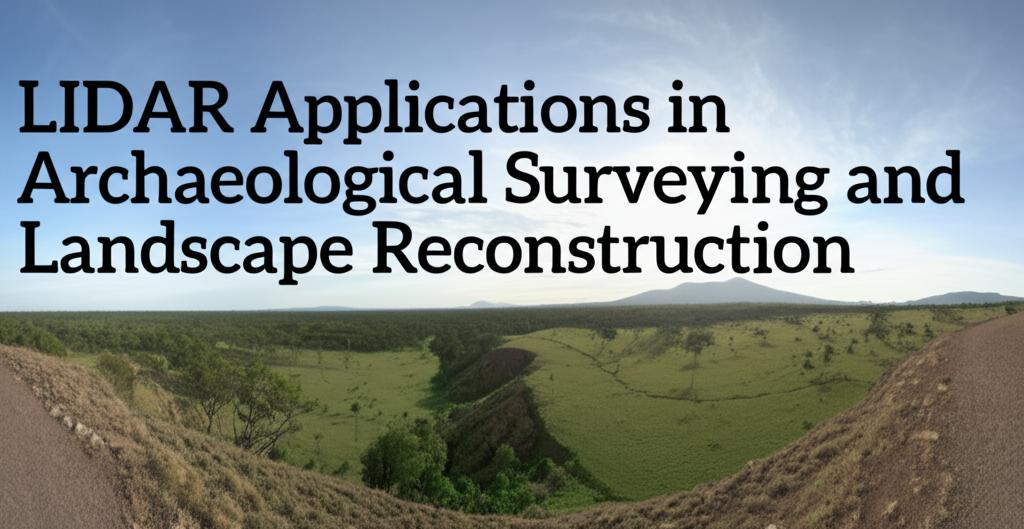LiDAR (Light Detection and Ranging) technology has significantly advanced archaeological surveying and landscape reconstruction, offering unprecedented ways to uncover and understand past human activities. Its ability to penetrate dense vegetation and create highly accurate 3D models of the ground surface has revolutionized the field, leading to remarkable discoveries and a deeper understanding of ancient civilizations.
Revealing Hidden Structures and Landscapes:One of LiDAR's most significant contributions is its capacity to "see through" forest canopies and other ground cover that can obscure archaeological sites. By emitting millions of laser pulses from an aircraft (like a plane or drone) and measuring their reflections, LiDAR creates detailed digital elevation models (DEMs) of the terrain. This process, sometimes referred to as "digital deforestation," reveals subtle topographic features that indicate human-made structures such as buildings, roads, canals, agricultural fields, and fortifications, which would be invisible to the naked eye or traditional aerial photography.
Recent examples of LiDAR's power in this area include:
- Maya Civilizations: In Guatemala and Mexico's Yucatán Peninsula, airborne LiDAR has unveiled tens of thousands of previously unknown Maya structures, including farmsteads, ceremonial complexes with pyramids and ball courts, vast urban networks, elevated highways (sacbeob), irrigation systems, and defensive features. These discoveries have dramatically reshaped our understanding of the scale, complexity, and population density of Maya societies.
- Amazon Rainforest: LiDAR surveys in the Amazon Basin have challenged the long-held notion of an "untouched" rainforest by revealing extensive pre-Columbian settlements with geometric earthworks, demonstrating significant human alteration of the landscape. In 2024, LiDAR helped uncover the oldest urban settlements found in the Amazon, with over 6,000 interconnected earthen platforms in Ecuador dating back 2,000 years.
- Angkor Wat, Cambodia: While the main temples of Angkor Wat were well-studied, LiDAR mapped the sprawling medieval urban network surrounding them, including reservoirs, roads, and neighborhoods that supported a large population. It also shed light on the massive water management systems and their eventual failure.
- Silk Road Cities in Uzbekistan: In 2024, drone-based LiDAR revealed two long-hidden medieval cities, Tashbulak and Tugunbulak, situated at high altitudes in the mountains of Uzbekistan. These discoveries highlight that mountainous regions were active hubs along the Silk Road. The detailed maps showed fortresses, plazas, roads, and residential structures, with Tugunbulak spanning 120 hectares, making it one of the largest medieval cities in the region.
- Roman Roads and Fortifications: LiDAR has been instrumental in tracing lost Roman roads and understanding the extent of their networks. In Romania, a 5,000-year-old fortress, obscured by dense forest, was precisely mapped using LiDAR in 2025, revealing intricate defensive ditches and earthen mounds from the transition period between the Neolithic and Bronze Age.
LiDAR data allows for analysis at multiple scales:
- Micro-scale: Detailed examination of individual structures, revealing building shapes, orientations, and construction volumes. This can provide insights into labor investment and astronomical alignments.
- Meso-scale: Comprehensive views of settlements, cities, and their relationship to the surrounding topography and resources. It facilitates the study of land use practices like agriculture and water management.
- Macro-scale: Understanding broad spatial patterns beyond individual sites, including the distribution of populations, communication networks, and even the implications of "vacant" spaces within a landscape.
The technology has evolved from bulky and expensive equipment to more compact, lightweight, and cost-effective Lidar sensors that can be mounted on drones (UAVs). This "democratization" of LiDAR has made it accessible for a wider range of archaeological projects, including smaller-scale research. The integration of GPS and SLAM (Simultaneous Localization and Mapping) technology has further enhanced the precision and effectiveness of LiDAR surveys.
Integrating Data and Understanding Human-Environment Interaction:A significant aspect of current LiDAR application is the integration of this data with other information sources, such as historical records, excavation data, and environmental analysis. Lidar point clouds also provide detailed information on vegetation structure, allowing researchers to assess how modern vegetation might reflect past ecological conditions that shaped human behavior. This helps contextualize LiDAR findings within a broader landscape archaeology framework. Digital Twin creation, combining LiDAR data with 3D photogrammetry and other sensor data, is being used to create comprehensive digital replicas of archaeological landscapes like Uruk-Warka in Iraq, facilitating visualization, simulation, and long-term preservation.
Limitations and Challenges:While incredibly powerful, LiDAR is not a standalone solution. It excels at mapping surface and near-surface features but cannot penetrate solid ground to detect deeply buried artifacts or structures. For these, other geophysical methods like ground-penetrating radar (GPR) or magnetometry remain essential. LiDAR helps identify promising areas for targeted excavation where these other methods can be employed. Another challenge is the ethical consideration of data ownership and the responsible management of the rapidly increasing volume of LiDAR data being generated.
Future Directions:The future of LiDAR in archaeology looks promising, with trends pointing towards:
- Integration with Artificial Intelligence (AI): AI algorithms can assist in the automated identification and classification of archaeological features from vast LiDAR datasets.
- Enhanced Accuracy: Ongoing advancements in sensor technology will likely lead to even higher-resolution data, allowing for the detection of more subtle features.
- Virtual Reality (VR) Applications: LiDAR data can be incorporated into VR platforms to create immersive and interactive educational experiences of ancient sites.
- Time-Series Analysis: Repeated LiDAR surveys over time can help monitor changes in archaeological sites and landscapes, aiding in conservation efforts and understanding landscape evolution.
In conclusion, LiDAR technology continues to be a transformative tool in archaeological surveying and landscape reconstruction. It allows researchers to uncover vast, previously hidden aspects of our past, providing new insights into the complexity, scale, and environmental interactions of ancient societies across diverse geographical regions. As the technology becomes more refined and accessible, it promises to unlock even more secrets buried beneath vegetation and the passage of time.

